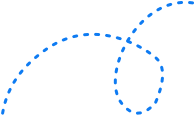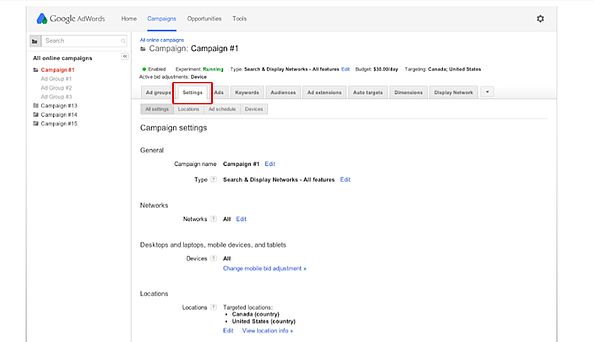Proven Ways To Stop Google Ads Click Fraud 


Is click fraud costing you precious AdWords dollars? Are fake clicks losing you customers?
Google Ads (formerly known as Adwords) is packed with money-making opportunities.
And wherever there’s money to be made, fraudsters are never far away.
The fact is, click fraud is worse than ever.
No matter the size of your business, or your Adwords budget, nobody is entirely safe.
But just because they’re out there ready to strike doesn’t mean you have to let them win. The digital world is already competitive enough!
That’s why, it’s never been more important to stand up and battle click fraud to make sure you get the ROI and customers you deserve.
This is so crucial for running profitable pay per click advertising campaigns (PPC) and getting the results you’ll really love.
Here’s a rundown of what click fraud is and how you can prevent it.
What is Adwords click fraud?
Click fraud is a black-hat technique of clicking on pay per click ads to generate fraudulent charges for advertisers.
This illegal technique occurs across multiple advertising networks.
However, today we’re focusing on one of the most popular: Google Adwords.
What are the main sources of Adwords click fraud?
Medium to low volume clicks
Most click fraud on Adwords comes from competitors.
Advertisers are trying to hijack their competitors by driving up their costs and forcing them to meet their budget caps early in the day.
Say you are running a Google Ads campaign with a daily budget in place. Once your budget has been reached, the ad turns itself off to stop further clicks.
By clicking your ads, your competitors can waste your PPC advertising budget and turn the ad off for the day.
Now for the really sneaky bit.
If your competitor is currently in position 2 and can’t afford to outbid you for position 1, they can waste your budget by repeatedly clicking your ad.
Eventually, position number 2 will steal the top spot, gaining all the extra clicks and extra traffic for free!
High volume clicks
Competitors aren’t the only offenders.
There are also professional fraud rings who target expensive keywords backed by big companies.
These offenders use automated computer programs and clickbots to generate millions of fraudulent clicks and views per day. While some bots are looking to scrape contact information, others are designed to click on your ads hundreds or thousands of times to deplete your ad budget.
In addition to bots and web crawlers, click farms are another click fraud set up to keep an eye out for. Click farms are designed to click multiple times on unspecified links and are most often used by businesses to inflate engagement.
Competitors aren’t the only offenders.
There are also professional fraud rings who target expensive keywords backed by big companies.
These offenders use automated computer programs and clickbots to generate millions of fraudulent clicks and views per day.
Finally, there’s the worst of the worst…
Site owners are manually clicking their own ads to generate revenue from their own clients.
Regardless of who commits click fraud, the result is the same:
Piles of wasted online advertising spend.
According to Juniper Research, ad fraud causes businesses to lose $51 million a day.
Every. Single. Day.
In 2017 alone, around 1 in 5 clicks on adverts were fraudulent, with that number growing every month.
The latest statistics show that ad fraud continues to be the number one problem for marketers. More than 50% of online ads are not seen by humans, leading publishers to miss out on a considerable portion of their revenue. Advertisers lost more than $23 billion globally to ad fraud in 2019, and it’s predicted that ad fraud will cost the industry $32 billion by 2022.
But it’s not just about the wasted ad spend – click fraud also distorts the analytical data you rely on for online marketing decisions.
Say you have a Google Ads campaign with a high converting and profitable keyword. If that keyword suffers from click fraud and you don’t detect it, you might decide to get rid of the keyword.
After all your data shows the click-through rate is extremely high, but the conversion rate is extremely low. Because you get charged for every click, the cost of the ad will eventually outweigh the profit.
Click fraud has distorted the reality causing you to make a decision that could impact your whole marketing ROI.
What can be done?
How to stop Adwords click fraud
Before we take you through what you need to do, you’re probably wondering what Google is doing about click fraud.
Rest assured Google has created the most robust anti-click fraud program of all the search engines.
It includes:
- Automated detection systems using machine learning and complex algorithms to detect and filter out invalid clicks in real time, before advertisers are charged.
- Google’s Ad Traffic Quality Team constantly monitors and analyzes traffic to detect and remove any clicks they deem invalid before advertisers are charged.
- Investigations based on advertiser reports of suspicious activity.
But you cannot rely on Google alone.
There are steps YOU need to take to identify click fraud and protect your Adwords ROI.
How to identify click fraud on your AdWords account
How do you know whether malicious clicks are happening in YOUR account?
The good news is, depending on the time and resources you can commit, there is a lot you can do to identify whether you are a victim of click fraud.
Going the DIY Route
One DIY way of approaching click fraud is to use internal reporting.
In order to track click fraud with your internal reporting, make sure you collect the following information:
- IP address – Every user has an IP address, like a home address for your internet activity. When you visit a site, you leave an IP address trail that can be tracked by webmasters.
- Click timestamp – the time when someone arrives on your site after clicking an ad.
- Action timestamp – the time when that person completed an action on your site.
- User agent – features of the device on which they are browsing.
Got the information?
Excellent.
Now, use the click timestamp and action timestamp together. You are looking for the IP addresses that are arriving at your site repeatedly by clicking on your Google Ad, but not taking any action.
Do you see an IP address with a heap of click timestamps but no action timestamps?
This is probably click fraud.
Now, look at the user agent.
This takes note of all the features of the device being used to access your site, such as the type of device, internet browser, software, etc.
In short, it shows you whether someone on a particular IP is the same person.
If you discover a potentially fraudulent IP address, what now?
Find out who it belongs to by performing a quick check of the IP. Go to a website like What is my IP address.
If you see that a significant portion of your traffic is coming from the same place, make sure to check if the suspect IP address belongs to a proxy server. If the search queries triggered from the IP in question are varied, it’s likely a proxy server. However, if the searches are similar, the clicks are likely fraudulent.
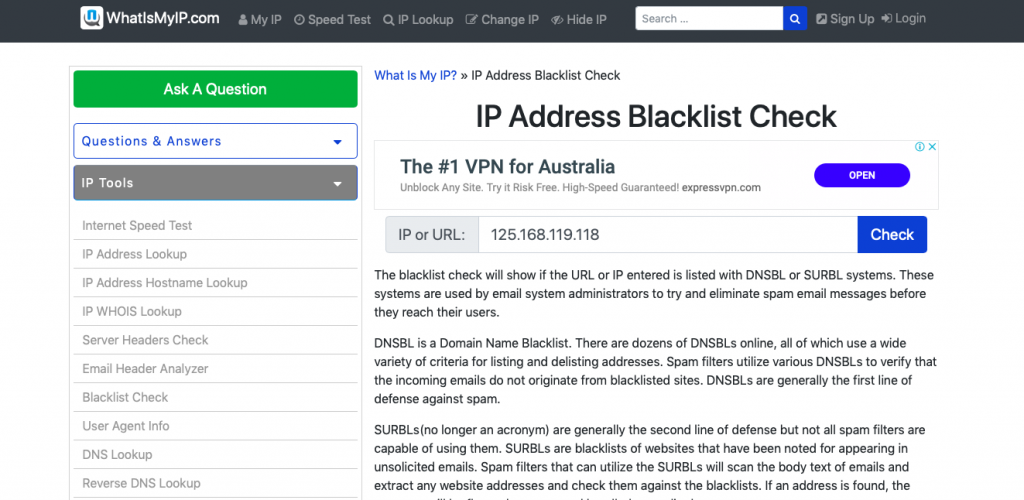
If you identify Adwords click fraud, report it straight to Google so they can investigate.
How to prevent click fraud on your AdWords account
Feel like you can’t rely on Google to weed out all the invalid clicks? We get it.
While you can’t completely eliminate the risk of click fraud, there are ways to take matters into your own hands to prevent click fraud on your AdWords account.
Try these eight proven tactics to reduce the risk of being a click fraud victim:
- Set up IP exclusions
- Be aware of competitors
- Adjust ad retargeting
- Only target high-value sites
- Monitor invalid clicks
- Run remarketing campaigns
- Set conversion tracking pixel on something you can clearly map
- Invest in fraud detection software
1. Set up IP exclusions in Google Ads
If you’ve done your checks and know there are IP addresses responsible for click fraud, you can block your Google Ad from being served to that IP address in the future.
You simply need to set up an exclusion in your Google Ads account.
- Go to the Settings tab.
- Click on the campaign you want to exclude IP addresses from.
- Go to Advanced settings and select the IP exclusions link.
- Click Edit.
- Type in the offending addresses (up to 500 per campaign).
- Click Save.
Job done!
From now on, Google will not display your ads to these addresses.
This is a highly effective way of protecting your account from click fraudsters.
The bad news is it can be incredibly time-consuming if you have lots of IP addresses to block.
WARNING: Be careful not to exclude potential customers.
Users often have multiple IP addresses because they browse the internet at home, work, and in cafes. This doesn’t mean they are click fraud culprits!
Make sure you have done the right checks before excluding them.
For more tips, download your own Digital Marketing Game Plan – it’s completely FREE!
2. Be aware of your competitors
Having the potential to tank advertising budgets, it’s easy to see why click fraud gives competitors an easy advantage.
Always pay attention to who is competing with your keywords in the search engines. Use Google to search for the keywords you are considering targeting, and see which other businesses are also creating ads for those keywords. Determine if the keywords you have in mind have commercial intent by checking the competition in paid search.
You can also note any other relevant keyword phrases you can target, again checking for commercial intent. Use the relevant keyword phrases to help you find more specialised keywords to target, thus lowering the number of competitors for your ads but increasing the likelihood of clicks and conversions.
Finally, analyze the ads your competitors are using. Try to glean insights from the ad formats, copy, and landing pages your competitors are using, paying particularly close attention to the text being used to describe the product or service and the way the brand encourages conversions.
You can also use click tracking tools like SEMrush and iSpionage to find out if and when your competitors are clicking your PPC ads.
3. Adjust your ad targeting to specific countries
A small tweak to your targeting could be all that’s needed to weed out fraudulent clicks.
Is your click fraud coming from a specific geographic region or country?
Sometimes click fraudsters hire real people to click on ads. These are called ‘click farms’.
They are not always located in the same place, but typically they will be in countries with notoriously cheap labour.
Exclude these locations and their language from your Google AdWords campaigns. Don’t run ads in countries where you can be an easy click fraud victim.
If you suspect that your main competitor is the fraudster, exclude their postcode.
WARNING: Be careful not to block the HIGH CONVERTING traffic when excluding locations.
4. Only target high-value sites
Often associated with bots that automatically target your site and ads, low-quality websites are a huge source of click fraud. Avoid low-quality websites by only running your ads on sites you know are full of potential customers.
Both Google and Yahoo! allow you to set up ad campaigns that only run ads on the sites you specify, thereby avoiding sites that take from your ad spend.
5. Keep a close eye on your campaigns and monitor invalid clicks
To determine whether your pay per click advertising campaigns are bringing you genuine visitors, always monitor and track your advertising campaigns.
If you use Google AdWords, the Campaign Performance and Account Performance allow you to see the number and percentage of clicks that Google has categorised as invalid.
To view invalid clicks on your Google AdWords reports, click the Campaigns tab and select “modify columns.” Find the performance tab and select the options to show invalid clicks and interactions in your campaign data:
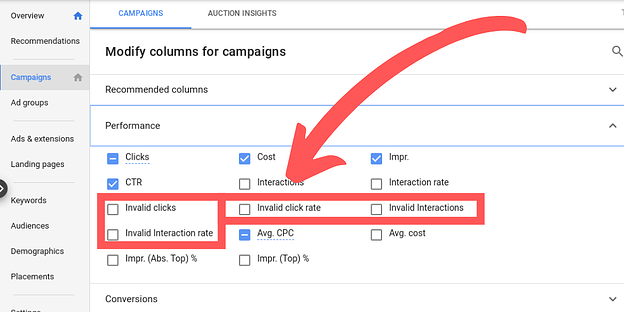
Image Source: Acquiso
Any invalid clicks that you’ve received will be noted under your transaction history:
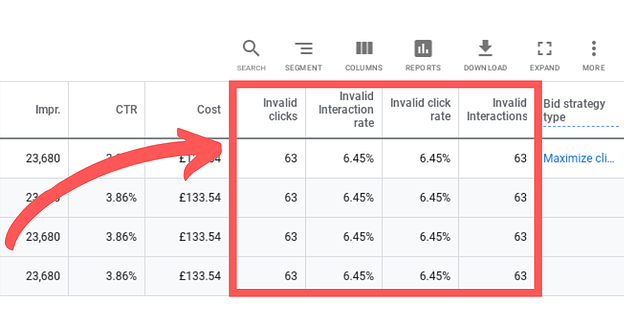
Image Source: Acquiso
Make sure to reconcile the costs, and if your account reimbursements don’t match, raise a support ticket with Google so that you aren’t paying for invalid clicks.
6. Run remarketing campaigns
Remarketing is where you provide ads to people who have visited your website in the past. This means your ad is only shown to people who have demonstrated a real interest. Maybe they visited certain web pages, downloaded an ebook, put a product in their shopping cart, etc.
There’s zero risk of click fraudsters jumping on the ads because they can’t see them in the first place!
7. Set the conversion pixel on something you can clearly map
Conversion tracking is the most effective way to measure and evaluate the success of your Google AdWords campaigns.
You install their conversion tracking pixel onto the pages of your site.
The pixel will fire whenever users click on your Google Ads campaign and visit the pages that trigger the conversion tracker.
So, how can you use conversion pixels to stop click fraud?
Spam sites use bots to register heaps of “easy” conversions, such as on lead forms.
Because they’re getting heaps of conversions, Google’s algorithms reward them by serving your ads on those sites even more.
The result?
You wind up wasting heaps of PPC budget on fake conversions. The trick is NOT to use conversion tracking on something that doesn’t take much time and effort, like filling in a form.
Instead, place your conversion pixel on more involved actions, like free trials or when you know they have actually bought from you.
Making this small change will reduce fake conversions and give you much more accurate ad campaign data.
8. Invest in fraud detection software
Click fraud software detects and protects against fraudulent activity related to PPC advertising. A good way to stop click fraud is to invest in a software solution designed to identify the sites sending suspicious amounts of visitors to your site.
Anti-click fraud programs actively monitor your Google Ads traffic and automatically blacklist sources of invalid clicks. In short, investing in click fraud software can help you stop money-wasting clicks and optimize your advertising campaigns to increase conversions and profits.
Over to you
The simplicity of click fraud means it can happen to anyone. But you should be able to stay on top of it by following this article’s tips.
Here’s a quick recap on how to get started:
- 1. Identify click fraud by gathering the right information
- 2. Exclude dodgy IP addresses
- 3. Tweak your ad targeting
- 4. Run remarketing campaigns
- 5. Be smart with your conversion pixels
No time to do all this?
The truth is running Google Ads campaigns can be time-consuming, especially if it’s not your expertise.
By working with a PPC agency, you can sleep easy knowing your campaigns are raking in the conversions and all the right tactics are in place to prevent click fraudsters from wasting your budget.
If you are already working with a Google Ads agency, they should be on top of it. Just ask them what they are doing to prevent click fraud.
OMG keeps ahead of the latest black hat tactics, so we can protect your AdWords campaigns and squeeze the maximum return on investment.
Find out how we can help you get more out of Google Ads, without more effort. Get your free digital growth audit (worth $2000!).

